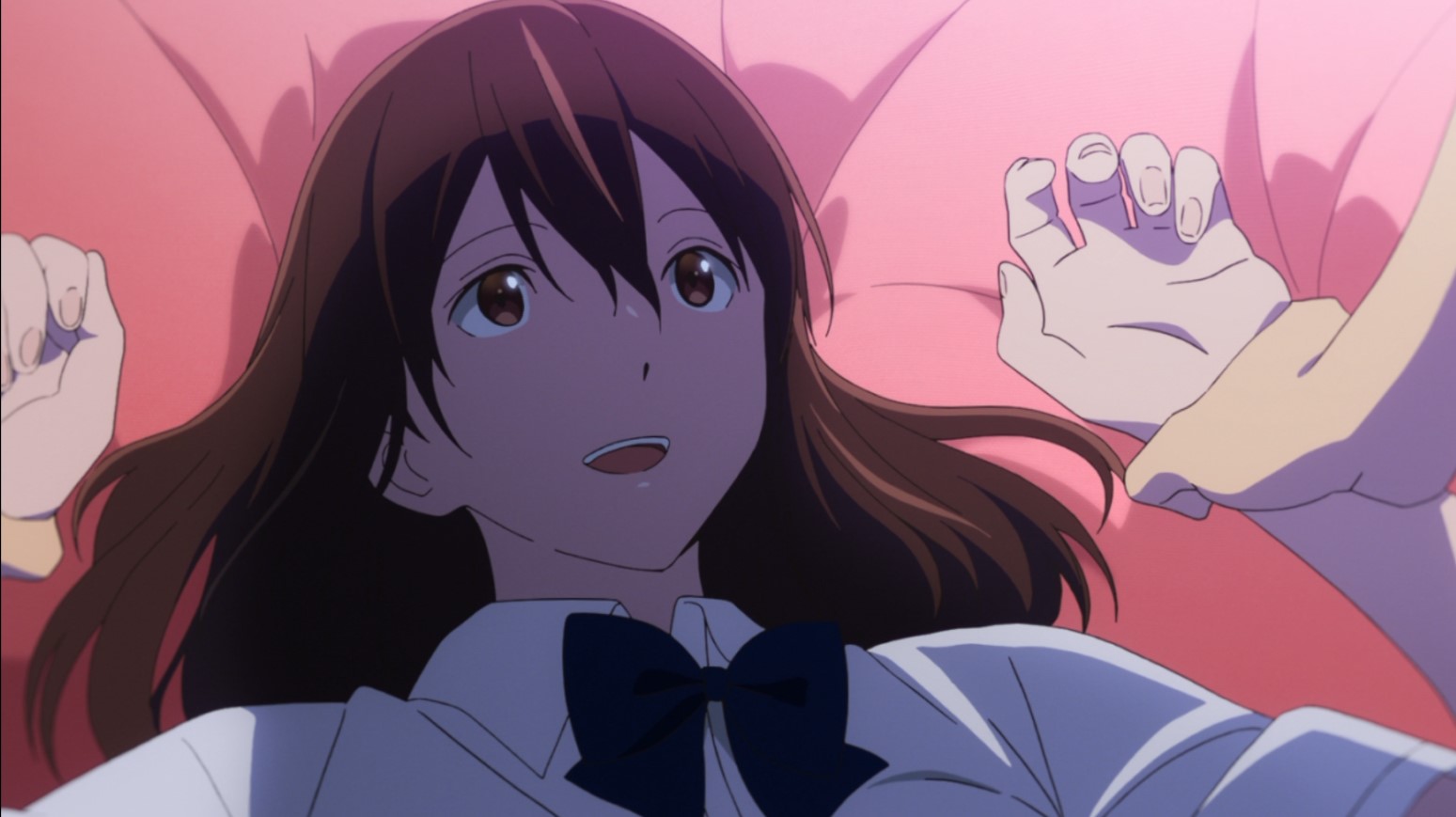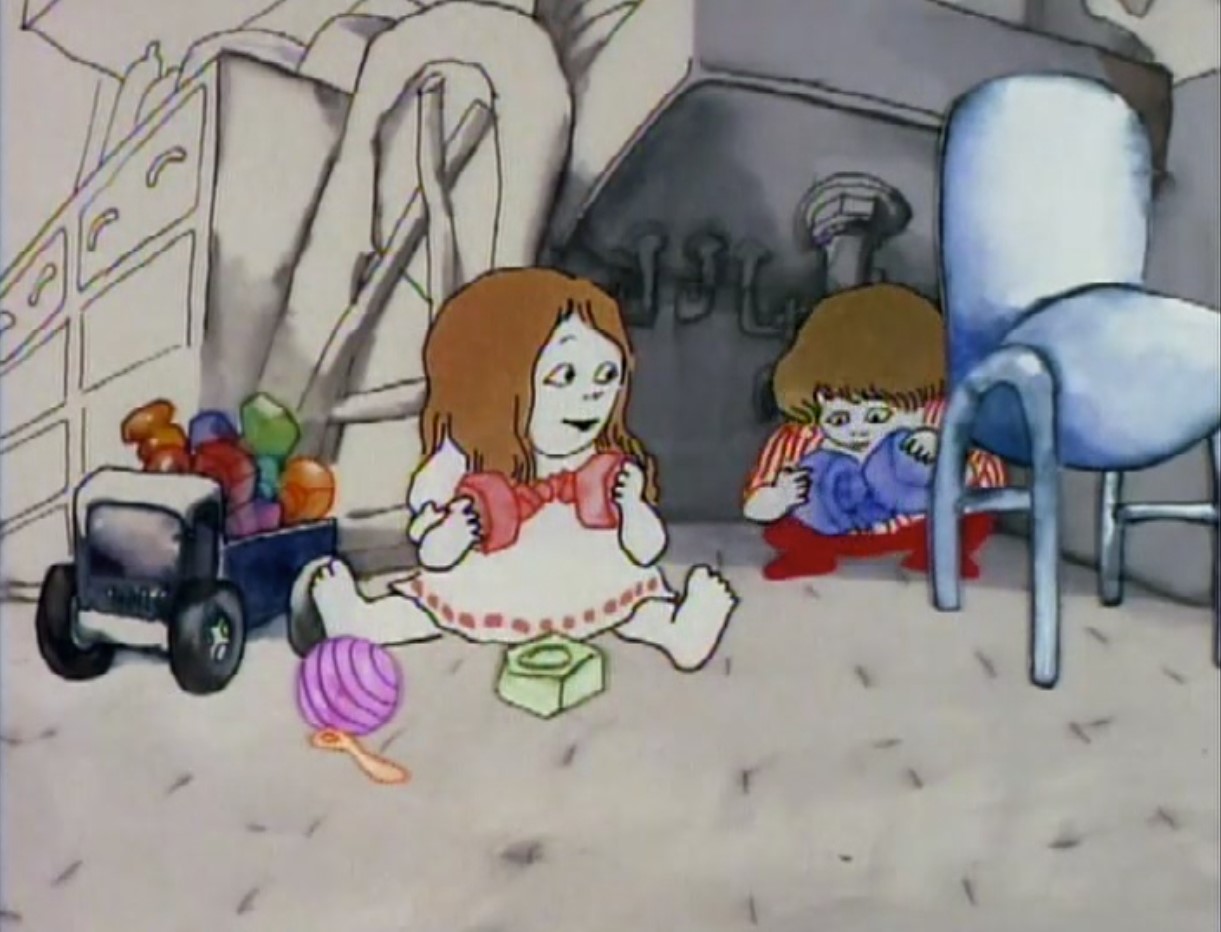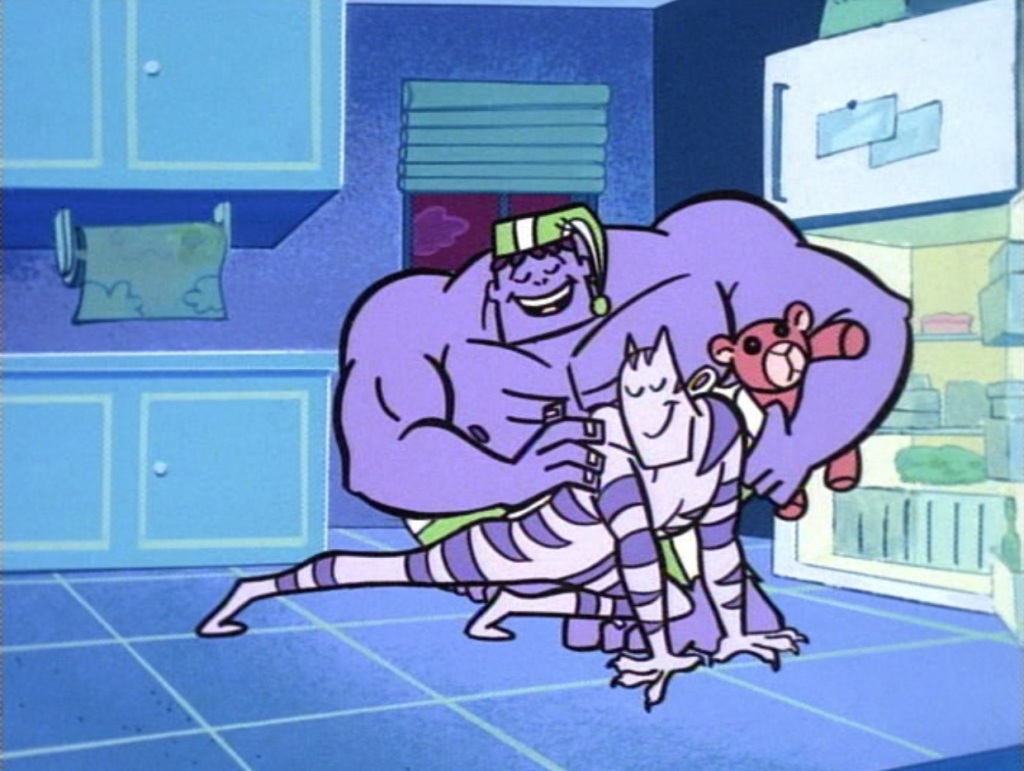You are currently browsing the category archive for the ‘★★★★’ category.
Director: Fyodor Khitruk
Release date: 1962
Rating: ★★★★
Review:
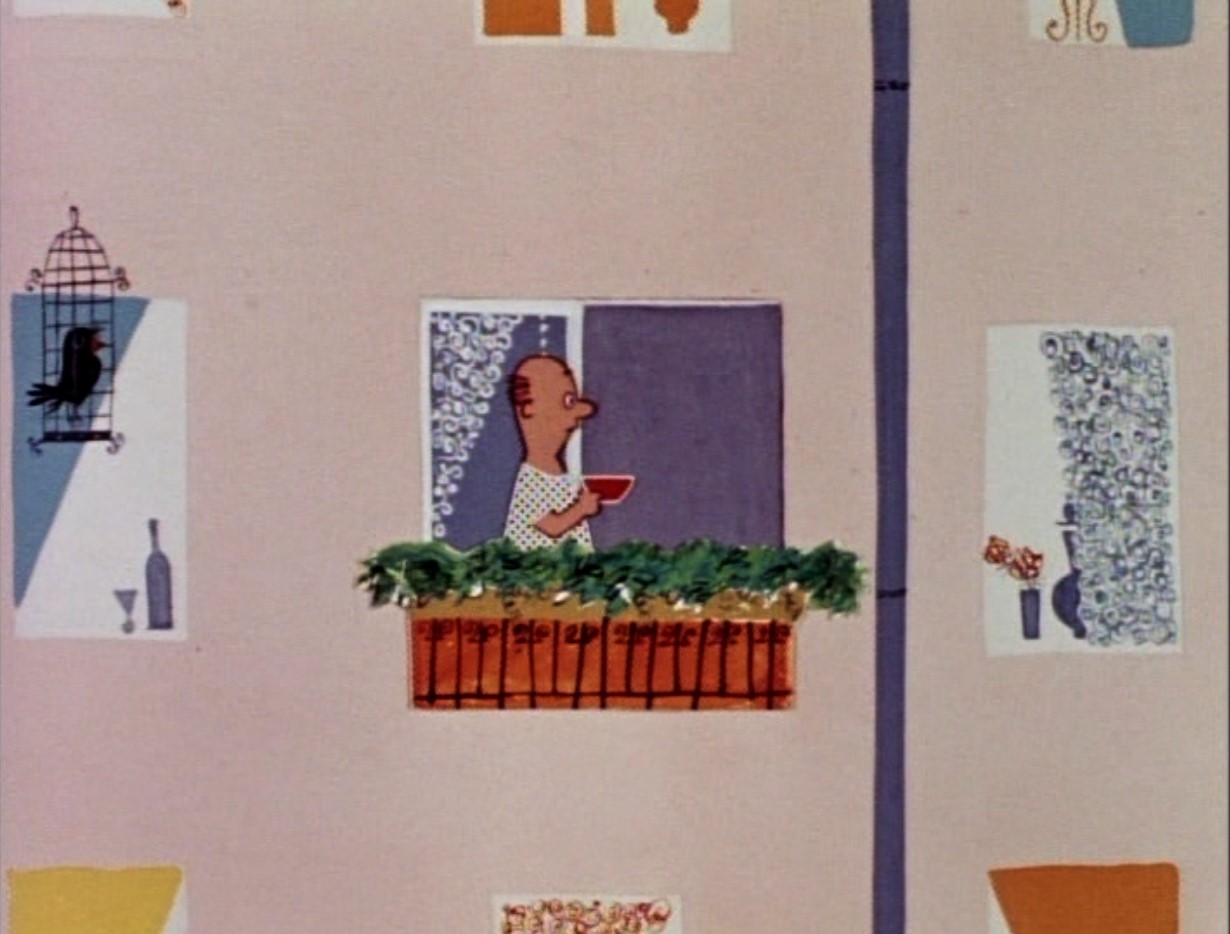
‘Story of One Crime’ was the first film directed by acclaimed film maker Fyodor Khitruk (1917-2012). Khitruk was one of the best comic talents in the Soviet era, as is already visible in this delightful early film.
The short starts with a man sneaking upon two talking ladies and hitting them with a large pan. At that point the narrator interrupts and takes us viewers 24 hours back. The rest of the film is told wordlessly, and shows the criminal, comrade Manin, to be a nice, gentle and hard working man. We watch him going to work, and working at the office.
All seems well, but as soon as he returns to his home, in an apartment block, the problems start. When he wants to rest on his balcony, he’s disturbed by ridiculously loud domino players playing in the courtyard. When he returns inside to watch some television, a neighbor turns on some loud jazz music, and later, when he tries to sleep, more neighbors deprive him of a good night’s rest in various ways. The film ends with a message to the viewers themselves, no doubt, more often than not living in such noisy apartments themselves.
Khitruk tells his tale with an understated sense of humor, and a relaxed, but effective sense of timing. The animation is limited, and far from fluent, but as Khitruk knows how to pose, very effective. The designs by Sergei A. Alimov, too, are a delight: the film is a rare example of Soviet cartoon modern design, and both characters and backgrounds are gorgeous throughout the film. They are partly made by snippets from magazines, and especially the neighbor’s gargantuan stereo installation is a great example of good cut and paste work.
With ‘Story of One Crime’ Khitruk took Soviet animation away from the classic fairy tale worlds of the 1950s into the modern age. The film contains some criticism on Soviet society, which is depicted as less than ideal, but the film was an enormous success, nonetheless.
With this short Khitruk immediately became one of the Soviet Union’s most important animation film makers, as he would prove, e.g. by delivering the world his delightful ‘Vinnie Puch’ (Winnie the Pooh) films of 1969-1972.
Watch ‘Story of One Crime” yourself and tell me what you think:
‘Story of one Crime’ is available on the DVD ‘Masters of Russian Animation Volume 1’
Director: Jan Lenica
Release date: 1961
Rating: ★★★★
Review:
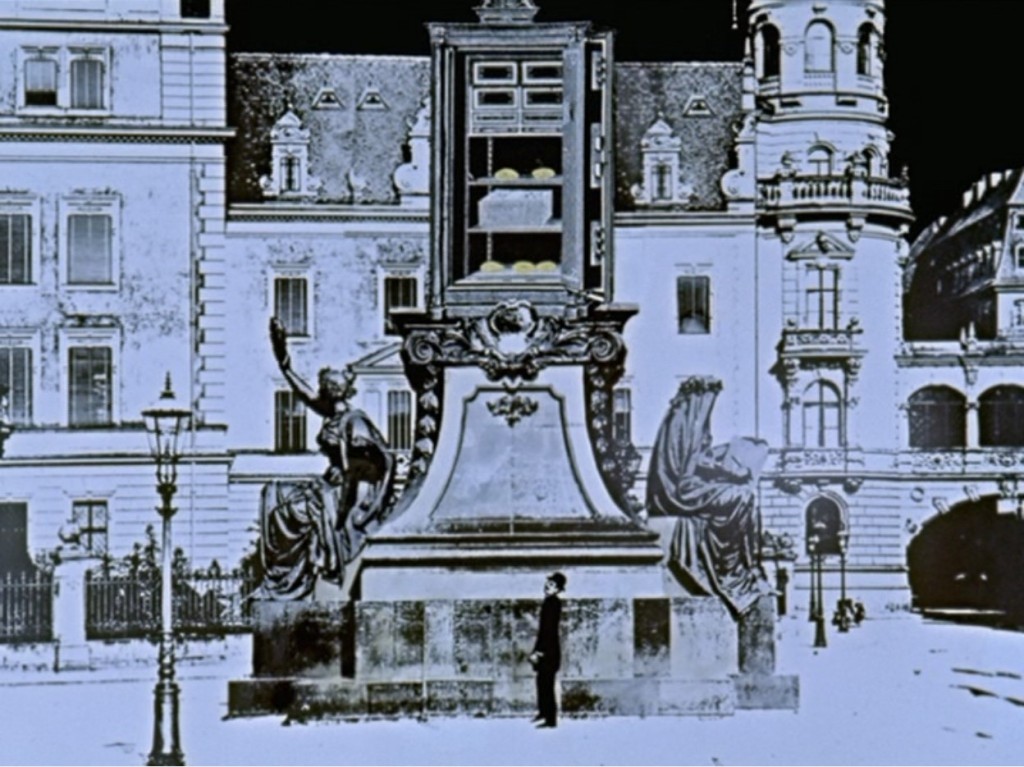
In ‘Labirynt’ a man flies into a seemingly abandoned city, only to find it to be a dangerous place, terrorized by strange creatures and machines, alike.
This is one of those rare animation films from Eastern Europe depicting what it’s like to live in an oppressive communist state. The film is highly surreal, featuring strange creatures, often mixes of animal and human parts, but I am still surprised the film got past the censors. For example, at one moment the man is captured by a bearded machine-man and thoroughly examined. At one key scene we watch is thoughts roaming freely inside his head, only to get barred by a strange contraption. The end, too, in which the man tries to escape the paranoid city is telling enough.
Jan Lenica’s world is based on partly colored old photographs and engravings. His animation is emblematic, but at one point we surely feel the man’s fear, as he tries to flee from his oppressors. The surrealist atmosphere is enhanced by Jan Radlicz’s sound design and by Włodzimierz Kotoński’s score.
Watch ‘Labirynt’ yourself and tell me what you think:
‘Labirynt’ is available on the DVD-set ‘Anthology of Polish Animated Film’
Director: John Lounsberry
Release date: December 20, 1974
Stars: Winnie the Pooh, Piglet, Tigger, Rabbit, Kanga, Roo & Christopher Robinson
Rating: ★★★★
Review:

The third of the Winnie the Pooh-featurettes is based on chapter seven and four from ‘The House at the Pooh Corner’ and both stories are centered around Tigger.
Now Tigger was from the start a wonderful character, superbly animated, and he shines again in his second appearance after ‘Winnie the Pooh and the Blustery Day’ from 1968. In both stories Tigger’s main adversary is the serious and rather sour Rabbit, who, too, is greatly animated, and the enormous difference in movement and expressions between the two characters is a great testimony of what character animation is all about, and of the extraordinary art of the nine old men.
As the two stories are very simple and straightforward, it’s best not to say much else about them, but in the second one Pooh himself is at his best when he discovers some mysterious tracks in the snow. There’s again a little playing with the book setting, even if it’s less than in the previous featurette.
The result is another delightful little film that will appeal to youngsters and adults, alike.
‘Winnie the Pooh and Tigger Too’ was planned as the last of the Winnie the Pooh featurettes, and in 1977 all three were combined into a feature (which had been Walt’s original plan, anyway) called ‘The Many Adventures of Winnie the Pooh’, which adds one last and moving little scene to end it all. Nevertheless, 1983 saw another Winnie the Pooh short ‘Winnie the Pooh and a Day for Eeyore’.
And even that was not the end of the Disney-Pooh-adventure, as in 1988 the television series ‘The New Adventures of Winnie the Pooh’ started, followed by a few television specials and several straight to video features. And of course, in more recent times, the Winnie the Pooh franchise has gotten an update with films like ‘The Tigger Movie’ (2000) and ‘Piglet’s Big Movie’ (2003). One would almost blame the Disney company for milking the Pooh franchise too much, especially when getting far away from the source material, but then the company surprised us with the absolutely delightful ‘Winnie the Pooh‘ from 2011.
Watch an excerpt from ‘Winnie the Pooh and Tigger Too’ yourself and tell me what you think:
‘Winnie the Pooh and Tigger Too’ is available on Blu-Ray and DVD as part of ‘The Many Adventures of Winnie the Pooh’
Director: Caroline Leaf
Release date: 1974
Rating: ★★★★
Review:

‘The Owl Who Married a Goose: An Eskimo Legend’ was the first film acclaimed animator Caroline Leaf made for the National Film Board of Canada.
Done entirely in sand animation the short tells about an owl, who marries a goose, but cannot follow her life style, with disastrous results. The legend is told and sung by real inuit, who also provide the goose’s and owl’s voices. As their Inuktitut language remains untranslated, one is lost in what is said, but luckily Leaf’s charming animation tells it all.
With its simple designs, effective animation and original soundtrack ‘The Owl Who Married a Goose: An Eskimo Legend’ created quite a stir, and the film surely is one of the most Canadian the NFB ever made. After this film Leaf set off to a great career as one of the most interesting of independent animation film makers, creating such intriguing masterpieces like ‘The Street’ (1976) and ‘Two Sisters’ (1990).
Watch ‘The Owl Who Married a Goose: An Eskimo Legend’ yourself and tell me what you think:
‘The Owl Who Married a Goose: An Eskimo Legend’ is available on the DVD ‘Best of the Best – Especially for Kids!’
Director: Marcell Jankovics
Release date: May 27, 1977
Rating: ★★★★
Review:

‘The Struggle’ is as short as Jankovics’s previous film, ‘Sisyphus’ (1974), and again in black and white. This time Jankovics uses pencil on a white canvas to depict a sculptor sculpting a human figure. But then the sculpture itself starts sculpting back…
Jankovics’s design is very realistic, and his animation of the highest quality, but the film is less interesting to look at than ‘Sisyphus’ because this time Jankovics shows more than he suggests. Nevertheless, this is a clever little film that like ‘Sisyphus’ shows that Jankovics was one of the greatest and most interesting animators ever.
Watch ‘The Struggle’ yourself and tell me what you think:
‘The Struggle’ is available on the Blu-Ray of ‘Son of the White Mare’
Director: Marcell Jankovics
Release date: 1974
Rating: ★★★★
Review:

‘Sisyphus’ is a very short animation film, which is indeed about a man pushing a large rock up a steep hill.
The animation is done in black pen on white paper, and there’s no background art whatsoever. Most impressive is Jankovics’s animation: his command of the human form is formidable, and of the suggestion of muscles pushing up an enormous weight absolutely convincing. What’s even more wonderful is that the man is rendered in various variations of abstraction, from quite realistic to only suggestive splashes of ink. The soundtrack, with its very heavy breathing and growning, maybe a little too much, but this short is a wonderful example of the marvelous things animation can do.
Watch ‘Sisyphus’ yourself and tell me what you think:
‘Sisyphus’ is available on the Blu-Ray of ‘Son of the White Mare’
Director: Zbginiew Rybczyński
Release date: 1976
Rating: ★★★★
Review:

Avant-garde animator Zbginiew Rybczyński, of later ‘Tango’ fame, brings us a fun little children’s film based on a poem by Julian Tuwim on trains.
The poem is set to lively jazz music by Janusz Hajdan, which Rybczyński accompanies with images of anything but trains. The lyrics are illustrated associatively, with animated pictures of a baby, a dog, an elephant. etc.
The most common element is a fat moustached man, done in pixilation. The pixilated photos are rendered in monochromes, mostly on a monochrome green canvas, which give the film a unique and very avant-garde look. Apart from the pixilation there’s a little, rather cartoony cel animation that convinces less.
‘Locomotive’ may be much less compelling than ‘Tango’, this children’s short already show that Rybczyński was a very original and idiosyncratic film maker.
Watch ‘Locomotive’ yourself and tell me what you think:
‘Locomotive’ is available on the DVD-set ‘Anthology of Polish Children’s Animation’
Director: Marcell Jankovics
Release date: May 3, 1973
Rating: ★★★★
Review:

Hungarian director Marcell Jankovics (1941-2021) is most famous for his second animated feature, the mind-blowing masterpiece ‘Fehérlófia’ (Son of the White Mare) from 1981. But his first feature, ‘János Vitéz’ certainly deserves to be equally famous.
‘János Vitéz’ was Hungary’s ever first animated feature ever, but this doesn’t show, at all. The feature is a remarkably mature product that owes nothing to earlier animation films, save George Dunnings’ ‘Yellow Submarine’ from 1968 (and one scene of a devils’ dance, which harks all the way back to Disney’s Silly Symphony ‘The Goddess of Spring’ from 1934). Like Dunning’s film, ‘János Vitéz’ uses very striking visuals in bold colors, and with a genuine contemporary design. In fact, no movie from the seventies looks so enormously ‘seventies’ as this film.
The film was commissioned by the Hungarian government to commemorate the 150st birthday of Hungary’s national poet Sándor Petőfi (1823-1849), whose stature in Hungary is comparable to that of Pushkin in Russia. Petőfi wrote ‘János Vitéz’, a long epic poem in 1844, and despite the strikingly modern visuals, the film follows the poem quite faithfully. János Gyulai-Gaál’s score is unmistaken Hungarian, akin to the music of Zoltán Kodály’s folk opera ‘Háry János’ from 1926 and contributes greatly to the utterly Hungarian character of the movie. There are also a few charming songs, adding to the experience.
The story is pretty nonsensical and more of a tall tale than a classic epic poem. It tells about the hero János Vitéz who is a sheep herder in love with the neighboring Iluska. Unfortunately, Iluska’s stepmother, the witch Mostoha, doesn’t approve of the young lovers’ romance, and makes János Vitéz’ flock of sheep disappear. Banished from his village, János Vitéz first joins a band of robbers, then joins the army, but keeps longing for his beloved Iluska.
The film retains much of Petőfi’s poetic quality: the dialogue is in rhyme, and the images themselves have a lyric quality. For example, the love of Iluska and János Vitéz is shown by associative images, full of flowers and a radiant sun. Moreover, a lot of the story is told through the images, and more by suggestion than by literally showing what’s happening. For example, when János Vitéz is banished this is shown by a street in which every house shuts its shutters when János Vitéz passes by.
The images are as folkloristic as they are psychedelic, and never cease to please or to amaze. The character designs are more of a mixed bag. János Vitéz and Iluska are drawn as rather bland beautiful people, while Mostoha, the robbers and the Turks are very cartoony. These and other characters provide some small gags. Character animation is absent. For example, when János Vitéz mourns for Iluska, this emotion is indicated more than heartfelt. Nevertheless, there is a clever use of metamorphosis and animation cycles, and it’s clear the animation is in service of the graphics and of the story.
In all, ‘János Vitéz’ is a joy to watch from start to end and deserves a much wider audience than it has now.
Watch an excerpt from ‘János Vitéz’ yourself and tell me what you think:
‘János Vitéz’ is available on the Blu-Ray of ‘Son of the White Mare’
Director: Dave Mullins
Release date: March 12, 2017
Rating: ★★★★
Review:
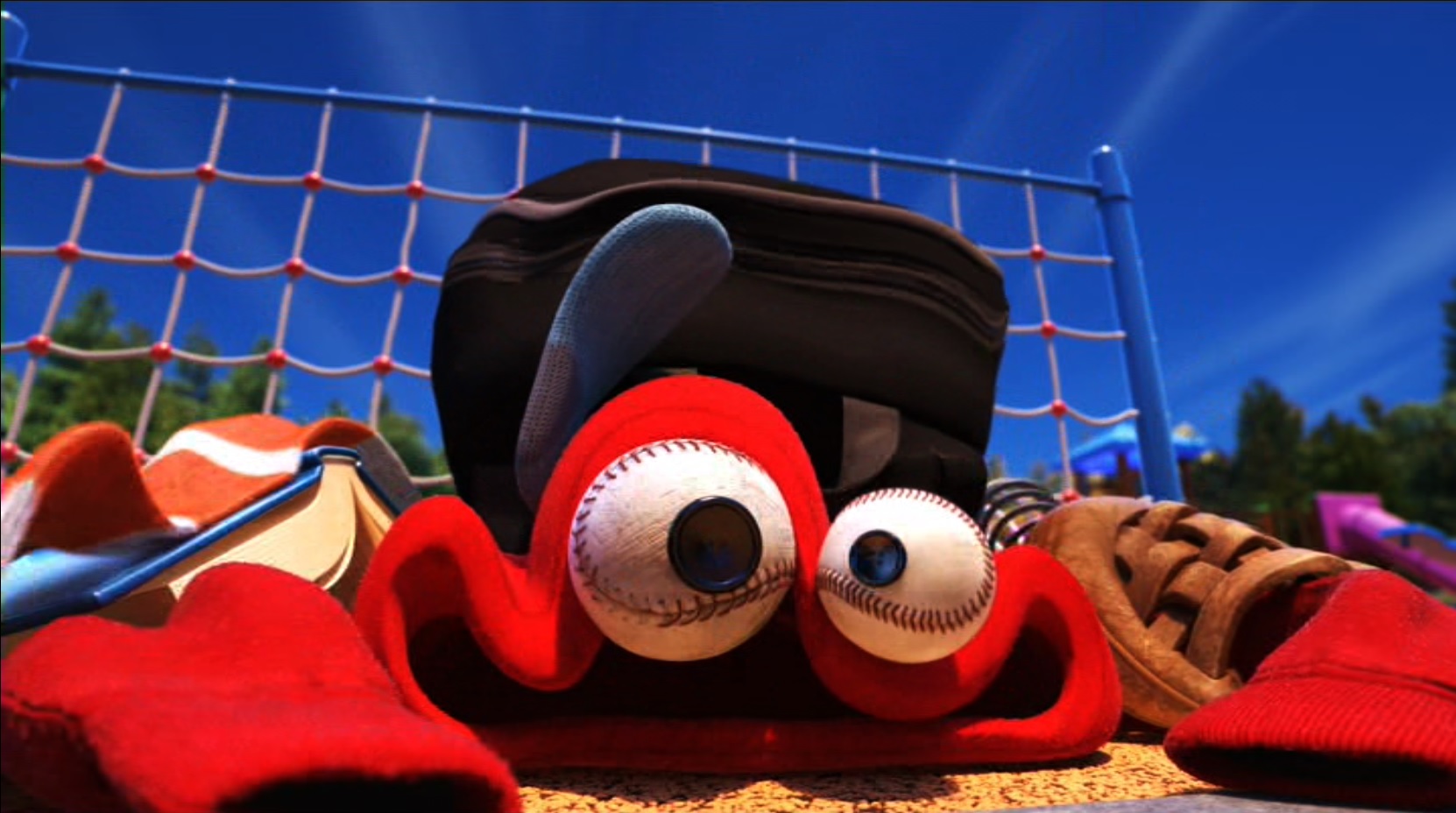
When, after recess, the playground of a school is empty, a mysterious being creeps out of the lost and found box to collect all lost toys from the site. He brings all these toys back to his lost and found box so children can find them there. But when he watches a bully taking toys from other children, he comes into action…
‘Lou’ is a short that is well-made but in an uninteresting generic Disney-Pixar style. Nevertheless, the story is well-told. There’s no dialogue, but the film manages to move the audience through clever timing and a well-placed flashback, showing the origin of the bully’s behavior. This part may be over-simplistic, but does give some depth to the bully character.
Moreover, the mysterious lost and found thing is a wonderful invention: it is essentially shapeless and only exists through the lost items. During the chase scene the thing thus changes its form repeatedly, in a wonderful sequence of variations on the same set of items. The origin of the title of the film is only revealed in the end.
Watch ‘Lou’ yourself and tell me what you think:
‘Lou’ is available on the Blu-Ray & DVD of ‘Cars 3‘ and on those of ‘Pixar Short Film Collection 3’
Director: Lev Atamanov
Release date: 1969
Rating: ★★★★
Review:

In ‘Ballerina on the Boat’ a ballerina boards a ship. When she practices her moves, several sailors try to copy her, but only succeed in falling overboard. In the end they all get so angry, the gentle ballerina retreats into her cabin. But that night she rescues the ship from a terrible storm.
‘Ballerina on the Boat’ is a very charming film using stark cartoon modern designs and watercolor backgrounds reminiscent of Raoul Dufy. Even the storm consists of beautifully colored paint strokes. The film thus has a strong 1950s feel, enhanced by the peppered modern music by star composer Alfred Schnittke.
The film uses no dialogue and has a very poetic feel, as the ballerina defies gravity more than once. The ballerina herself is animated beautifully and very convincingly, and indeed, two people are credited for choreography. If the film has one drawback, it’s its length. For, after all, not too much is happening throughout the 17 minute long short.
Watch part 1 of ‘Ballerina on the Boat’ yourself and tell me what you think:
‘Ballerina on the Boat’ is available on the DVD ‘Masters of Russian Animation Volume 2’
Director: Robert Proch
Release date: 2010
Rating: ★★★★
Review:

In ‘Galeria’ a woman goes shopping, accompanied by her husband, while their bull terrier has to wait outside.
Robert Proch treats this simple and rather boring subject with the greatest of elegance. His film is rendered in black and white only, with some occasional reds, and the semi-abstract pen drawings burst with animated life.
Add some original stagings, some great metamorphosis, a rather associative way of story-telling, and an excellent score by Tupika, and we can conclude that ‘Galeria’ is one of those shorts that shows what animation can do. Despite its dull subject matter, ‘Galeria’ is a triumph of imagination, and its dance-like quality is a delight to watch throughout.
Watch ‘Galeria’ yourself and tell me what you think:
‘Galeria’ is available on the The Animation Show of Shows Box Set 7
Director: Gorō Miyazaki
Release date: July 17, 2011
Rating: ★★★★
Review:

Like ‘Ocean Waves’ (1993) and ‘Whisper of the Heart‘ (1995) ‘From Up on Poppy Hill’ is one of those Ghibli films that could do well without animation. There’s no fantasy or metamorphosis around. Instead, the film is a modest little human drama. In fact, the film has much in common with the two earlier Ghibli features. Like ‘Whisper of the Heart’ ‘From Upon Poppy Hill’ has a female teenager star, and like ‘Ocean Waves’ there’s a strong air of nostalgia pervading the movie, especially in the gorgeous and evocative background art.
‘From Upon Poppy Hill’ takes place in harbor town Yokohama, somewhere between 1961 and 1963, before the 1964 Summer Olympics in Tokyo and after the release of the melancholic song ‘I Look Up as I Walk’ by Japanese crooner Kyu Sakamoto, which is heard several times during the movie, and which even became famous in the West back then, with the silly and out-of-place title ‘the Sukiyaki song’.
‘From Upon Poppy Hill’ focuses on teenager Umi Matsuzaki who lives with her grandmother and little brother at a boarding house with five female boarders, for whom Umi cooks breakfast and dinner. Umi’s mother is a professor, who’s abroad most of the time, while her father, a seafarer, has died in the Korean war (1950-1953). Each day Umi raises some signal flags in remembrance of her father. These are seen by Shun Kazama, a schoolmate who works at a tugboat. Both Umi and Shun thus are hard working children, so typical for the Ghibli studio.
The story focuses on the love that grows between Umi and Shun, and some unforeseen complications it raises. But there’s also an important subplot in which Shun and his fellow students try to protect their old club house called ‘The Latin Quarter’ against demolishing. Only when Umi starts to help, leading an army of female students, the protest gains momentum. The clubhouse scenes provide some comic relief in an otherwise emotional deep and heart-breaking story of friendship, love, and loss.
It’s impressive how the film makers show the emotions in the subtlest of ways. For example, at one point Shun evades Umi’s presence, but we see her reaction to this neglect only sparingly on her face, and with the slightest of actions. Thus, when Umi finally lets her emotions flow, it hits the viewer all the harder.
Hayao Miyazaki’s son Gorō Miyazaki does an excellent job as a director, and the animation is top notch, especially on the main characters. There are a few flashback scenes and there’s a short dream sequence, but otherwise there’s a strong unity of time and place, with all the action taking place in only a few settings and in a limited time frame. The film thus stays focused all the time, even when showing minor deviations from the main plot, like one of the boarders leaving the house.
In all, ‘From Upon Poppy Hill’ may be a modest film, in its emotional depth it’s in no way less impressive than the studio’s more outlandish masterpieces like ‘Spirited Away’ (2001) or ‘Ponyo on the Cliff by the Sea’ (2008). Highly recommended.
Watch the trailer for ‘From Up on Poppy Hill’ yourself and tell me what you think:
‘From Up on Poppy Hill’ is available on Blu-Ray and DVD
Director: Rosto A.D.
Release date: June 10, 2011
Rating: ★★★★
Review:
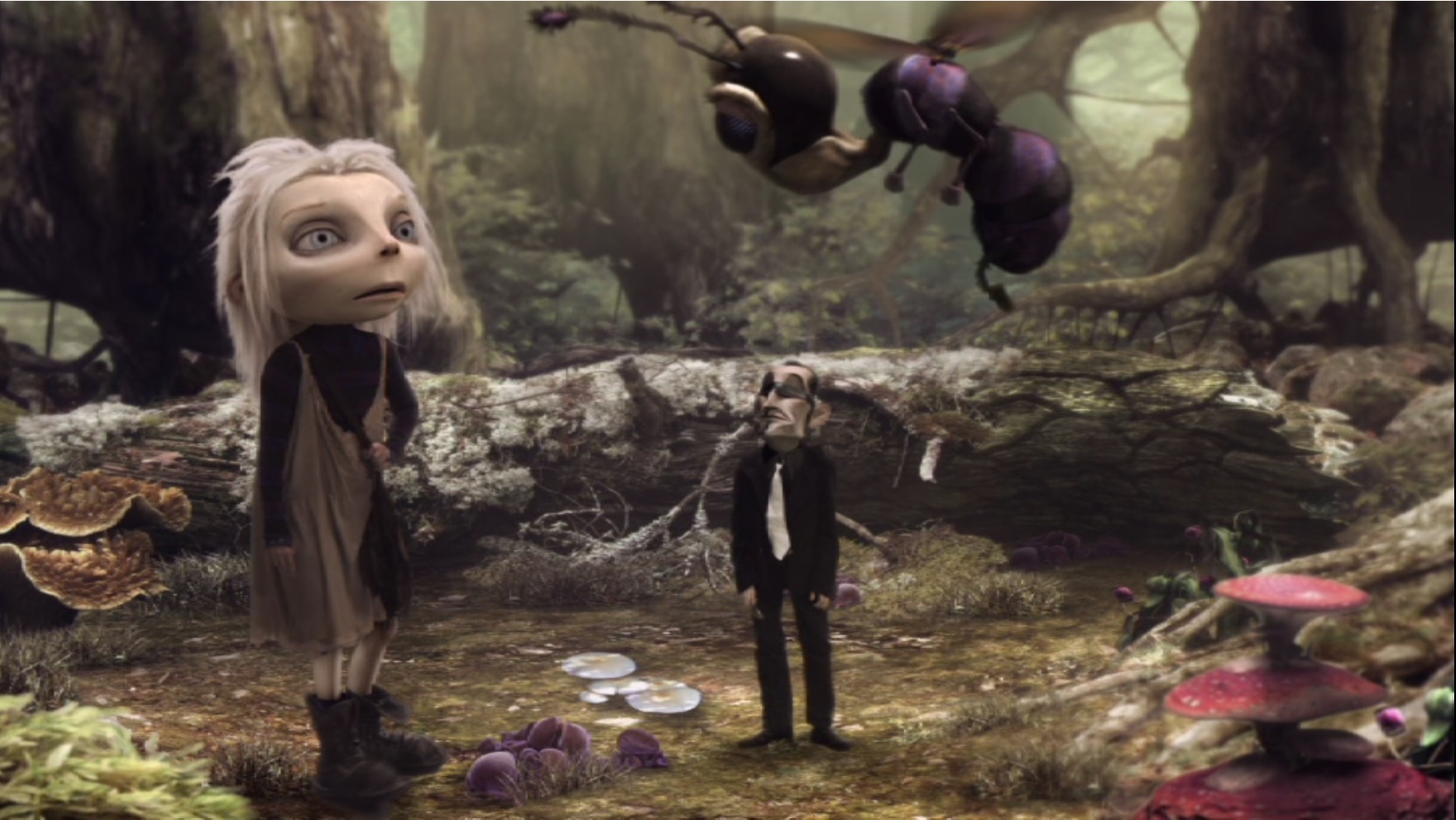
One of the most virtuoso and most idiosyncratic animated film makers ever to emerge from The Netherlands was Rosto (real name Robert Stoces). His films ‘(the rise and fall of the legendary) Anglobilly Feverson’ (2002) and ‘Jona/Tomberry’ created quite a stir, the latter winning the Grand Prix Canal+ prize at the Cannes Film Festival. In these fantastic films Rosto mixed live action, puppetry, and computer animation into a seamless mix. Moreover, they showed a unique if erratic voice that was completely its own.
‘The Monster of Nix’, Rosto’s most ambitious project, is no different. The film lasts half an hour and took six years to make. The short is essentially a musical with a rather post-modern tale-biting story, vaguely reminiscent of ‘The Neverending Story’. The film stars a boy called Willy (based on Rosto’s own son Max and aptly voiced by Joe Eshuis), who lives with his grandmother in a small village, surrounded by woods. Short after the film starts, Willy can’t find his grandmother. Even worse, many villagers have lost people and things, so Willy goes on a quest to seek his grandma and to find the evil monster behind this, finding strange creatures like Virgil, a giant swallow with human hands for claws and the woody “langemen” on his way.
‘The Monster of Nix’ boasts collaborators like Terry Gilliam (voicing a wood ranger), Tom Waits (voicing Virgil) and The Residents (performing two songs), as well as high production values. As expected from a Rosto film, the visuals are very strange, but compelling and overwhelming, seamlessly merging live action and animation to a unique mix. There are several rock music references, which are also typical of Rosto’s style, and there’s a spooky atmosphere akin to Tim Burton.
Rosto even composed the songs himself. Unfortunately, his score is more weird than attractive, and his story isn’t entirely convincing, either, reaching a rather dead point half way, never to recover entirely. But because of its unique atmosphere the film is well worth a watch.
Sadly, Rosto died in 2019, only fifty years old. His death is a grave loss to the Dutch animation world.
Watch the trailer for ‘The Monster of Nix’ yourself and tell me what you think:
‘The Monster of Nix’ is available on DVD
Directors: Stevie Wermers-Skelton & Kevin Deters
Release Date: March 5, 2011
Rating: ★★★★
Review:

The theatrical release of ‘Winnie the Pooh‘ (2011) came with a charming short called ‘The Ballad of Nessie’. Narrated by Scotsman Billy Connolly in Dr. Seuss-like rhymes the short tells about Nessie, who has to leave her small pond when one McFroogle turns it into a golf course.
Everything in ‘The Ballad of Nessie’ breathes nostalgia. The short is very reminiscent of Disney shorts from the 1950s, not only because of its use of rhyming narration, but also because of the full animation combined with cartoon modern designs, and Mary Blair-inspired background art. I especially liked the tartan hills in the background.
The short is not particularly funny, but clearly made with love, and a welcome return to traditional animation in a time even Disney abandoned its own classic art form for computer graphics.
Watch ‘The Ballad of Nessie’ yourself and tell met what you think:
‘The Ballad of Nessie’ is available on the Blu-Ray and DVD of ‘Winnie the Pooh’
Director: Gore Verbinski
Release Date: April 3, 2011
Rating: ★★★★
Review:

One of the most original mainstream feature films to come out of the United States in the 2010s was ‘Rango’, a Western with desert animals.
‘Rango’ was the brainchild of director and co-producer Gore Verbinski, a live action director of ‘Pirates of the Caribbean’ fame. The film was made at Paramount, which hadn’t had an animation studio of its own since the closure of the Paramount Cartoon Studio in 1967. In fact, the animation was essentially done at Industrial Light & Magic, supervised by Hal Hickel. Apparently, Paramount gave Verbinski a lot of freedom, because ‘Rango’ is a pretty quirky movie, boasting an original visual style and none too serious storytelling.
Star of this original Western is a pet Chameleon (Johnny Depp) with a lot of fantasy, who accidentally ends up in the Mojave Desert, where he poses as some kind of Western hero called Rango, prompting the villagers to appoint him as a much-needed sheriff. Rango then has to solve an aquatic crime, which he does cluelessly, but with much bravado.
The first thing that strikes ‘Rango’ as different from all other American computer animated films, is its surprisingly gritty visual style. Rango himself, for example, has a crooked neck and an asymmetrical head, while his love interest Beans is a lizard, whose curls do not hide the fact that she’s clearly a reptile. One of the villains, Gila monster Bad Bill looks particularly rough, while the mayor, a tortoise, looks uncannily like actor Fred MacMurray. Another curious addition is ‘the spirit of the West’, who looks like an aged version of Clint Eastwood’s ‘man with no name’ persona. The whole film breaths spaghetti western, especially in its cinematography and Hans Zimmer’s musical score.
‘Rango’ doesn’t really deviate from the familiar story lines of current American animated features, however. For example, there’s an ‘all hope is lost’ moment, a familiar trope in the 2000s and 2010s, but the story is unpredictable enough to entertain throughout. Moreover, apart from a unique visual style, the film boasts some off-the-wall story devices, like a band of mariachi owls, who bridge several scenes, frequently predicting the chameleon is going to die.
Although the crime plot is played with seriousness, the film never loses sight of its own silliness. There are some peculiar touches, like Rango talking to a halved armadillo, or Beans suddenly freezing mid-sentence. Much of the dialogue is delightfully funny, and there are plenty of references to Western cinema, as well as one to ‘Fear and Loathing in Las Vegas’ (1998), which also starred Johnny Depp.
Despite the silliness, the film boasts surprisingly high production values. The animation, the cinematography, the rendering and the soundtrack are all of a fine quality. The film’s scruffy look may not appeal to everyone, but is a welcome diversion from the mainstream.
‘Rango’ was such a commercial and critical success, even winning the Academy Award for Best Animated Feature that Paramount was confident to create its own animation studio, releasing its first feature, ‘The SpongeBob Movie: Sponge Out of Water’. Nevertheless, until now the studio has failed to carve out a unique spot in the crowded feature animation field. It at least never again released such a quirky movie like ‘Rango’.
Watch the trailer for ‘Rango’ yourself and tell met what you think:
‘Rango’ is available on Blu-Ray and DVD
Director: Michèle Cournoyer
Release Date: 1996
Rating: ★★★★
Review:

‘Le chapeau’ is a nonlinear, stream-of-consciousness-like film of flowing pen drawings morphing into each other on a white empty canvas, using the hat as a recurring motive.
The film is very associative, but it clearly says something about the male gaze and how it reduces women to mere objects of desire. The images show e.g. a female dancer dancing nude for a male audience, and images of sex. Most disturbing are the images in which the adult woman suddenly changes into a little girl and back, suggesting child abuse.
Cournoyer’s animation is flowing, her pen drawings are rough and sketchy, and her use of metamorphosis is mesmerizing. The result is a powerful, if rather uncomfortable short.
Watch ‘Le chapeau’ yourself and tell me what you think:
‘How Wings Are Attached to the Backs of Angels’ is available on the DVD ‘Desire & Sexuality – Animating the Unconscious Vol.2’

